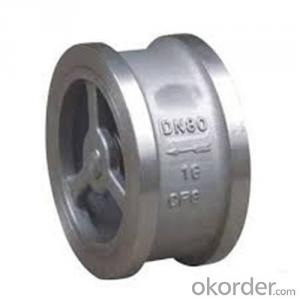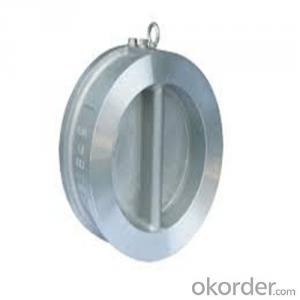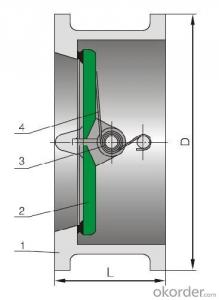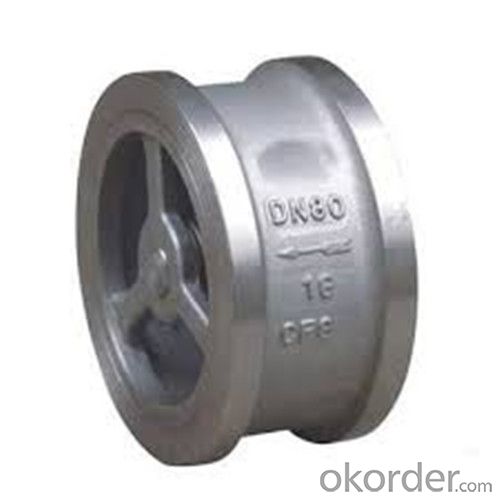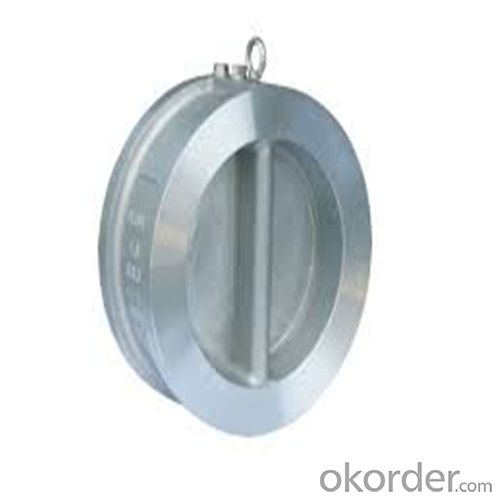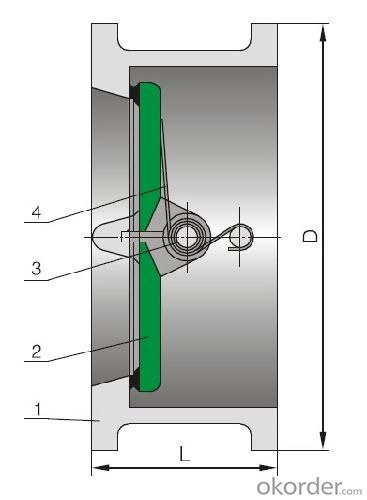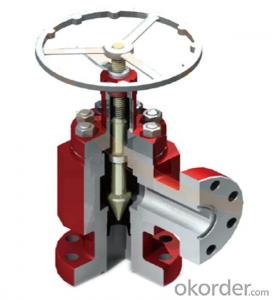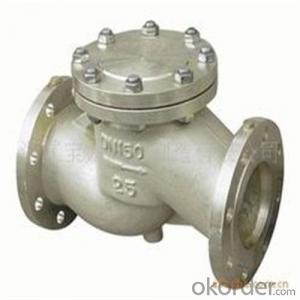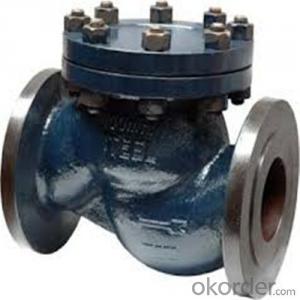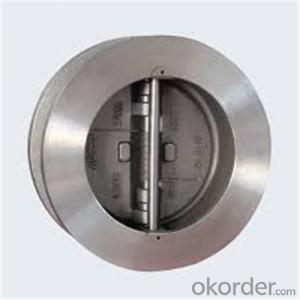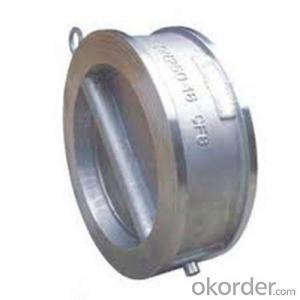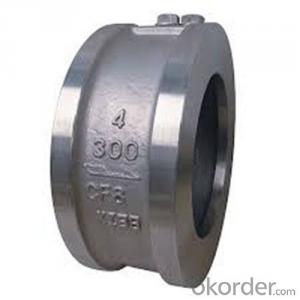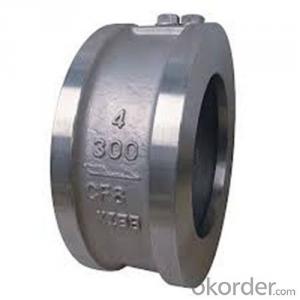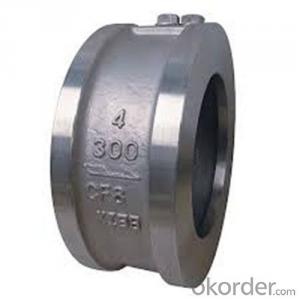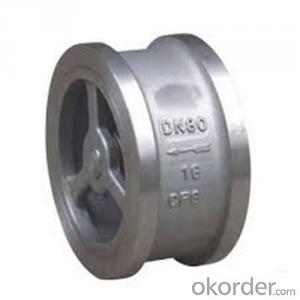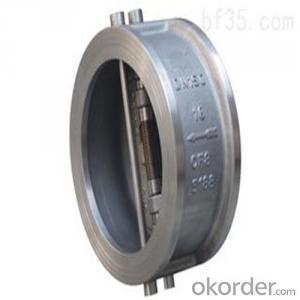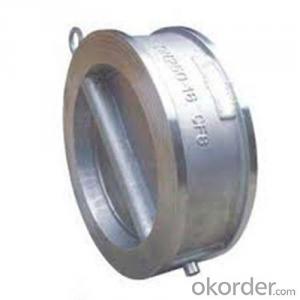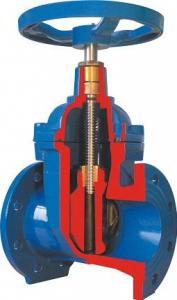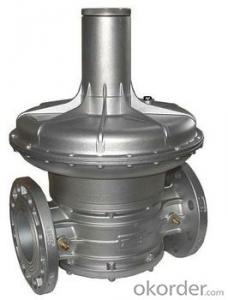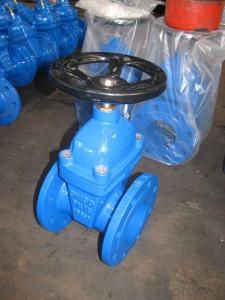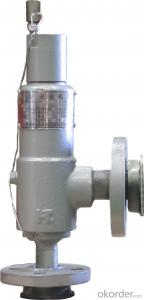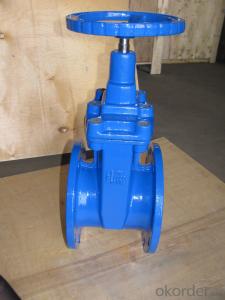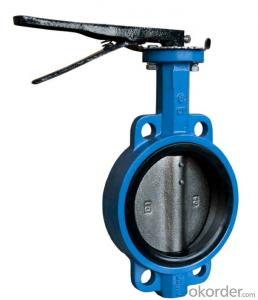Swing Check Valve Wafer Type Double Disc DN 450 mm
- Loading Port:
- Shanghai
- Payment Terms:
- TT OR LC
- Min Order Qty:
- 10 pc
- Supply Capability:
- 100 pc/month
OKorder Service Pledge
OKorder Financial Service
You Might Also Like
Products Description of Swing Check Valve
Check valves are used in pipes under pressures between PN1.6~16.0MPa(Class150~2500Lb), working temperatures-196~600℃, They are used in industries include oil, chemistry, pharmaceutical, fertilizer, and power gene-ration to prevent the backward flux of the media.
The main structure features of Swing Check Valve:
1、The products feature a reasonable structure, reliable seal, good performance and nice modeling.
2、Either soft or hard seal can be selected for the product upon different working conditions.The sealing face is built up with Co-based
carbide alloy, leaving a better wearability, corrosion and scrap resistance and a longer duration.
3、Small opening pressure, the disc can be opened fully with a very small pressure differential.
4、Inside-set bolt-bearing structure reduces leakage and reliable use.
5、PN≥16.0Mpa (class1500), the middle cavity uses a self-tightening sealing structure to have the sealing performance reinforced along
with the pressure rise so as to ensure the sealing performance.
6、Different parts materials and different sizes for flange, butt-welding are available for sensible combination according to different working facts and customers' requirements.
Parameter of Swing Check Valve:
Standard Criteria | GB customize |
Pressure Rating | 1 Mpa 1.6 Mpa 2.5 Mpa 4 Mpa 6.4 Mpa 10 Mpa 16 Mpa customize |
Valve Size | 50 mm 65 mm 80 mm 100 mm 125 mm 150 mm 200 mm 250 mm 300 mm 350 mm 400 mm 450 mm 500 mm 600 mm customi |
Actuator | Automatic customize |
Connection | Wafer customize |
Medium | Oil Steam Water customize |
Medium Temperature | -196~600℃ customize |
Structural style | Swing double-clack structure customize |
Application Fields | Agriculture Electricity Medical Petrochemical customize |
1-Body Material | CF3 CF8C CF8 WCB CF8M CF3M customize |
2-Disc | CF3 CF3M WCB CF8 CF8M CF8C customize |
3-Pivot | 1Cr13 1Cr18Ni9Ti 0Cr18Ni12Mo2Ti 2Cr13 customize |
4-Spring | 60Si2Mn 1Cr18Ni9Ti 4Cr13 0Cr18Ni12Mo2Ti customize |
Design Standard | GB/T 12224 customize |
Connection Standard | GB/T 9113 HG 20592 JB/T 79 customize |
Test Standard | JB/T 9092-1999 customize |
Face to Face | GB/T 15188.2-1994 customize |
Images of Swing Check Valve:
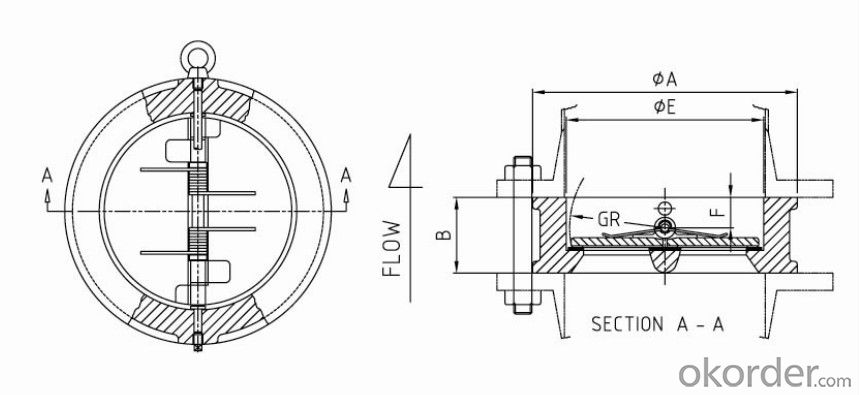
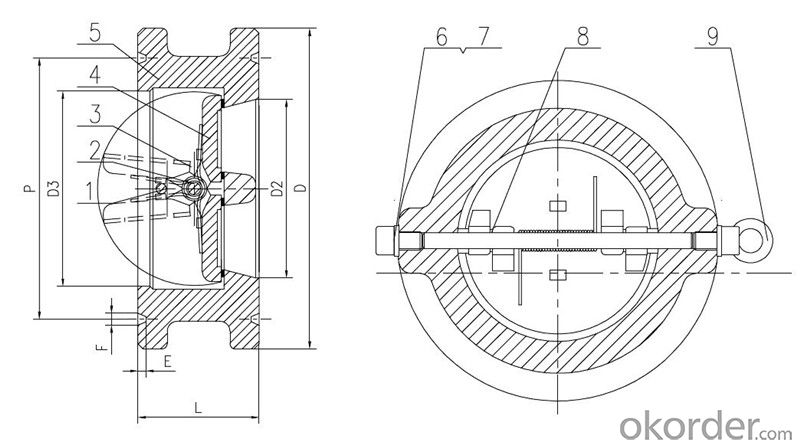
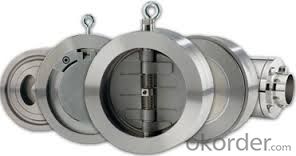
FAQ of Swing Check Valve:
Q1:I can’t find the type of steel check valve which I need. what can I do?
The chart above only lists out some common composition of steel check valve parts.We may provide other different parts material composition according to the customer's request or the actual valve working condition.
Q2:Which certification do your products pass?
Our products are in accordance with ISO 9001、ISO 14001、API 6A、API 6D、TS CE、API607/6FA/BS6755.
Q3:How can I place an order?
The only one thing you should do is to tell us the sepecification about type 、quantity and mode of transportation, then we will send you quotation within 24 hours.
- Q: I am working on my riding mower Briggs and Stratton 15.5 OHV. After replacing my headgasket my intake valve did not move when I turned shaft by hand. I took it back apart and believe I have my pushrods positioned correctly but cannot seem to get the rockkers back over the valves and rods. Maybe its because I am a girl and just need to man up but I thought it should be easier. Anyone got any tips?
- Panic? run around in circles? I have no thought what you prefer to do. yet in case you have been thinking, wanna comprehend how a lot of those little plastic rings that protection seal the bottle caps to the oil bottles i've got discovered under the valve cover? we could basically say lots, did they harm something? no, they only take a seat there, as there too great to pass down the oil galley and in the event that they have been that they had take a seat interior the backside of the oil pan or get caught to the oil pump %. up show screen, i'd desire to pass on approximately issues i've got discovered sitting in oil pans and caught to the show screen yet I wont, yet little products of RTV are on the ideal of the record, and if the show screen misses it your oil filter out won't.
- Q: I don't have one single water shutoff valve in my house that will shut anything off completely. It looks fairly easy to repack them, and I have the tools, and there are instructions all over the internet. The question I have for the experienced among you is what packing material do I use? I have heard graphite thread and teflon tape and even joint compound.Is one better than the other? Easier to use?Also, if there are any pitfalls I should know about before I undertake this, please advise.Thanks in advance!
- Well if you talking about the water shutoff valves under sinks then you need to first shut off the water comming into the house at the main shutoff valve near the street , Or at a line comming into the house that connects up to the valve you are trying to fix or you may take a slight bath while trying to fix the valve that wont shutoff. Then Go to the shutoff valve you want to repair in that line where you shut the water off at and unsrew the handle at the base of the handle shaft using two wrenchs to hold both the nut on the shaft while using the other to hold the shutoff valve .this will prevent twisting the valve right off the connecting lines. Most of the time you will find it has a rubber gromet attached by a screw to the handle shaft.this is what you need to replace with a new rubber gromet which you can get in an assortment box at wal mart or homedepot or lowes for a low price. If you are using teflon thread or jointcompound you are repairing a Pipe joint leak where water is leaking externally of the pipe,not a shutoff valve leak .
- Q: I am looking at getting a baritone horn of my own, but am not sure what compensating versus non-compensating valves are?
- It okorder /
- Q: its a vauxhall movara van and i need help im trying to found out wether the valves are broken all the springs are upright and all level , so does this mean there ok ? or not ... thanks
- The valve can be bent or broken under the head. Just because it looks right up top only means the stems are OK. The stems are usually OK, even if the valves are bent and broken. If it's making horrible valve noises and you're not sure, it's probably got a bent valve. Only way to know without pulling the head is to do a compression test.
- Q: I want to reduce the prssure of a liquid flow (ethanol) from 16.7 atm to 1.2 atm? Do I need more than one valve?
- One control valve can reduce pressure, as long as there is always a significant flow through it. The main reason for using more than one valve is usually to reduce or prevent cavitation caused by a large pressure change through a given valve. Ethanol has a pretty high vapor pressure, so cavitation might be a problem. Control valve manufacturers usually provide design guides for their valve trim choices (often in software form) that lead you through the choices and requirements. Each valve design has different limits. But, my seat of the pants feel is that you can do this with one valve. I have included an example. I am not specifically recommending this company. -- Regards, John Popelish
- Q: I'm looking for a valve that can be electronically controlled to open and close with a diameter of 1.5'(inches) to 2'(inches) and this valve must be able to withstand 20psi. Any websites or listings of stores I can go to would much appreciated. Thank you
- To okorder
- Q: I have a 1997 ford aerostar and my mechanic just called me and said that the pop off valve needs to be replaced, but it is attached to the line so the hole line has to be replaced to. I want to try to find the pop off valve to see if I can get it b/c he can't find the replacement part, what I need to know is what it looks like. or where it is on an aerostar, because I have 5 more sitting in the driveway and I can look for it.
- 1. the pop off valve is normally located in the compressor so if it over pressures it will relieve some of the pressure. it's not in a line. #2. if it's a 1997 it doesn't have R12. it has R134. the only valve in the line is the port to check pressures and vacuum and recharge it. it could have one of those valves leaking and most can be taken apart and a new schrader valve installed. hope this helps.
- Q: ok so my 1993 bonneville started shaking and its smells like gas fumes in the car, so i cant drive it cause i have a newborn baby.so i took it to the dealership, they said codes 53,54,55,42,66 came up. they said i needed a new cadiletic converter, so i went to a local muffler shop. they said it was glowing cause it was so hot and said that wasnt the problem.i called the dealership back and they said they cleaned the egr vavle but said maybe it needs to be replaced, well before i spend any money i wanted to get everyones opinion, the car drive great, only shake when ur at idle. and smells awful inside uld this be the egr valve ?
- You most likely have a bad egr valve. The valve is stuck open, that is why the idle is so bad. In normal operation, the egr is never open at idle. The valve being open at idle causes the map sensor to misread the manifold vacuum. This make the computer dump extra fuel through the injectors. That make the catalytic converter overheat, because there is raw fuel going into it. You may have already ruined the converter, but you want to deal with the egr valve first, then see if the catalytic converter is bad.
- Q: Sohc ZC (d15) honda I'm going to be painting my valve cover am I going to need new seals? What do I need to take it off and put it back on ? Please help I have the high temp sand paper all ready to go I just want to be ready
- You need to make use of heat resistant paint that is made for engines. Make certain that the valve cover has been cleaned very good with Acetone until all oil has been eliminated. Do not get paint on the gasket floor or your will have leaks where the gasket sealer fails at the paint. Most auto materials outlets have the high warmness paints in spray cans in plenty of colors. Simply be certain that you've got removed all the oil residue from the valve quilt and then paint it and let dry completely before reinstallation.
- Q: ive had my yz250f for more than a year and i havent had the valves adjusted......it still starts up in under 5 kicks and rides great.......are there any signs that indicate you need your valves adjusted besides not being able to start it?
- You'll hear the valves ticking. It will sound like a box of BBs clanking around in the top of the engine. Treat your engine to a valve adjustment and it will give you a long life, without any expensive engine repairs.
Send your message to us
Swing Check Valve Wafer Type Double Disc DN 450 mm
- Loading Port:
- Shanghai
- Payment Terms:
- TT OR LC
- Min Order Qty:
- 10 pc
- Supply Capability:
- 100 pc/month
OKorder Service Pledge
OKorder Financial Service
Similar products
Hot products
Hot Searches
Related keywords
